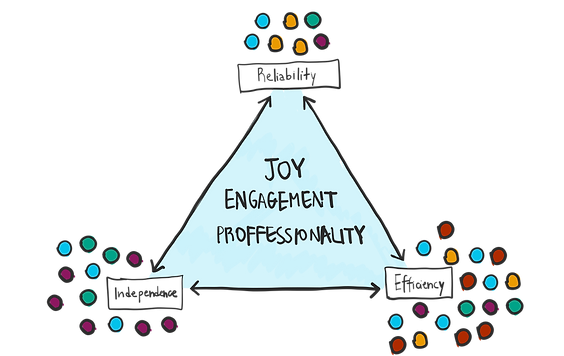

ENABLING CHANGE
DESIGNING TO EMPOWER SUNNAAS
Sunnas rehabilitation hospital
Sunnaas rehabilitation hospital is in a renovation process of their physical environment and their interest is to offer the best patient experience and maintain and strengthen their role as being among the leading rehabilitation hospitals.
They expect that after this project they can have a clear understanding of their needs
in terms of:
How to facilitate for their patients?
How should the staff work around the patient?
What is the impact on need for capacity?
Introduction
This project is an effort to encourage the involved actors to be more patient-centered in the process of renovation of the physical environment by employing co-creation techniques as well as Service Design tools and methods.
Result
A design kit was developed with five conversations called View Points. These materials are designed to empower different actors within the organization to turn conversations into concrete plans for action and innovation inside the hospital.
Details
In collaboration with Anath Hojman, Miryam pippich , Simón Sandolva, Sofie Thommasen, Thiago Freitas
Duration: 3 months
Projects
Installation of the lab

Like a patient arriving at Sunnaas for the first time, we stepped into a completely new place — unfamiliar with how things worked or who the people were. With all our belongings packed, we entered the room that would become our workspace for the next few months. From that moment on, we immersed ourselves in the daily life of the hospital, observing the flow of activities and interacting with staff, patients, and others throughout the entire project.
I'M AN ORIGINAL CATCHPHRASE

1st workshop
We met the team for the first time to get to know the people who would be working with us throughout the journey. It was also an opportunity to set goals together and build a shared understanding of the project.

Interviews

During our stay at the hospital, we conducted 25 in-depth interviews, spending around 18 hours listening to and learning from a wide range of stakeholders. This helped us build a deeper understanding of their perspectives, needs, and experiences.

Obsevation and shadowing
During our process, we spent time observing and shadowing different actors in the hospital, gaining a closer understanding of the challenges they face and the dynamics of their daily environment.
Findings presentation

2th workshop
Then came the moment to pause and reflect — to look at what we had accomplished, share our progress, and set a trajectory for the rest of the journey. We mapped and categorized different situations and practices to collect feedback, validate our insights, and prioritize the most pressing pain points that would guide the next steps of the project.
5 CONVERSATIONS
A design kit has been developed with five conversations called View Points. The idea was to use these conversations as a simple but powerful way to spark change from within. The materials weren’t just meant to be read or observed — they were created to bring people together, to pause the rhythm of daily routines, and to open up honest discussions about how things are done and how they could be better.
Through these conversations, we wanted to:
-
Give people the time and tools to reflect on their daily practices.
-
Encourage imagination and create space for new possibilities.
-
Transform ideas into concrete actions that lead to meaningful change.
Our goal was to make sure Sunnaas could carry this work forward on its own — using the tools to spark new initiatives, drive innovation, and build a shared vision for the future. More than a design kit, this project became a catalyst for empowerment, helping teams see themselves as active agents of change.
.png)

Sunnas rehabilitation hospital
Sunnaas Rehabilitation Hospital was in the middle of an important renovation of its physical environment. Their ambition was to offer the best possible patient experience while strengthening their position as one of the leading rehabilitation hospitals.
Through this project, the hospital aimed to gain a clear understanding of its future needs, focusing on:
-
How to better support and facilitate patients throughout their rehabilitation journey
-
How staff could work more effectively around and with patients to enhance the overall experience
-
How these changes would impact capacity, ensuring resources and spaces were used in the best possible way

Making Sense of the Findings
After analyzing the findings through different visual models, we organized them into five main categories: accessibility, articulation, adaptability, coherence, and empowerment.


Sunnas values
After categorizing the findings, it was interesting to see how they influenced Sunnaas’ core values — joy, engagement, and professionalism. This analysis revealed that the data was impacting three key areas:
-
The efficiency of processes and workflows
-
The patient’s independence
-
The patient’s trust and reliance on Sunnaas Hospital
Reserach methods and tools
We used an embedded design and participatory observation approach, working inside the hospital to build trust, understand daily dynamics, and gather meaningful insights.
_JPG.jpg)
User testing
We ran several user testing sessions with hospital staff and architects to better understand their perspectives and translate their ways of thinking, working, and communicating into the concept.

Designing for Collaboration
We wanted people to gather around the topic — to make the conversations tangible and accessible.
-
The size was designed to work both around a table and when hanging on a wall, encouraging collaboration in different settings.
-
The folding structure creates different moments, moving from general ideas to more detailed content.
-
The format is simple to reproduce, handle, and understand, making it easy to print and reuse multiple times.





Development of the material
Based on the feedback from the user testing sessions, we continuously refined and adjusted the concept to get closer to a solution that works for and supports the majority of actors involved.



